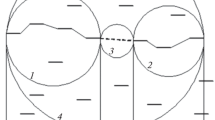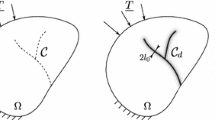Abstract
We present a general method for analyzing dynamically accelerating multiple co-linear cracks that can be applied to the contexts of plane strain or antiplane shear in an elastic material. The difficulty in solving such problems lies in the fact that the space-time regions containing known data evolve as the crack propagates in an a priori unknown manner. Using an analog to a Dirichlet-to-Neumann map, we can find complete knowledge of the stress and displacement along the fracture plane, facilitating the application of fracture criteria that require these values away from the crack tip. The method is demonstrated for a semi-infinite or finite mode III crack as well as for a pair of cracks in elastic material, using a stress intensity factor fracture criterion for simplicity.
Similar content being viewed by others
References
Costanzo, F. and Walton, J. (1997). A study of dynamic crack growth in elastic materials using a cohesive zone model. International Journal of Engineering and Sciences 35, 1085–1114.
Costanzo, F. and Walton, J. (1999). Numerical simulations of a dynamically propagating crack with a nonlinear cohesive zone. International Journal of Fracture 91, 373–389.
Freund, L. (1990). Dynamic Fracture Mechanics. Cambridge University Press, Cambridge.
Leise, T. and Walton, J. (to appear). Dynamically accelerating cracks. Part 2: A finite length mode III crack in elastic material. Quarterly Applied Mathematics.
Saraikin, V. and Slepyan, L. (1979). Plane problem of the dynamics of a crack in an elastic solid. Mechanics of Solids 14, 46–62.
Slepyan, L. (1974). Approximate model of crack dynamics. In: Dynamics of Continuous Media. Novosibirsk: Institute of Hydrodynamics of the Academy of Science, pp. 101–109 of Issue XIX–XX.
Slepyan, L.I. (1990). Mechanics of Cracks, 2nd edition. Sudostroenie, Leningrad.
Walton, J. and Herrmann, J. (1992). A new method for solving dynamically accelerating crack problems. Part 1: The case of a semi-infinite mode III crack in elastic material revisited. Quarterly Applied Mathematics, 373–387.
Willis, J. (1990). Accelerating cracks and related problems. In: Elasticity, Mathematical Methods and Applications. Edited by G. Eason and R. Ogden, Ellis Horwood Ltd., Chichester, pp. 397–409.
Author information
Authors and Affiliations
Rights and permissions
About this article
Cite this article
Leise, T.L., Walton, J.R. A general method for solving dynamically accelerating multiple co-linear cracks. International Journal of Fracture 111, 1–16 (2001). https://doi.org/10.1023/A:1010924215891
Issue Date:
DOI: https://doi.org/10.1023/A:1010924215891




